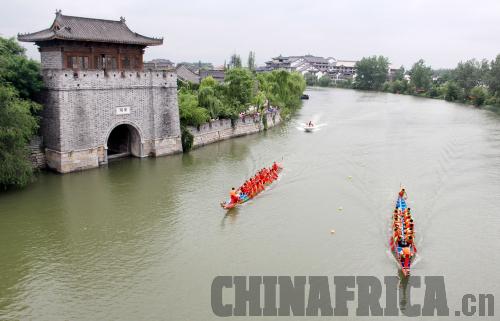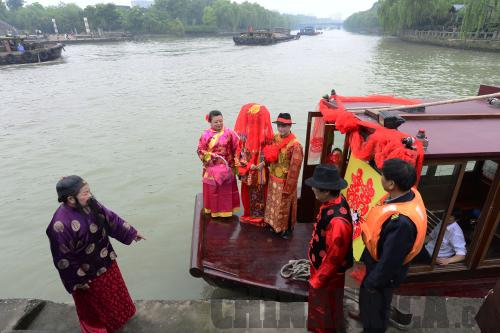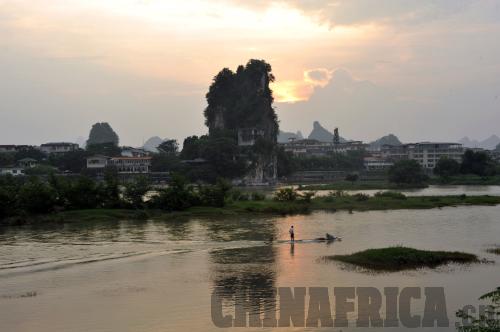| 
Dragon boat race on the Grand Canal Zaozhuang section ZHANG YANXIN
The hype surrounding the FIFA World Cup 2014 didn't seem to disrupt Tian Kezong's life too much. Despite being an ardent football fan, he has more important things to focus on in life. For more than two years the 40-year-old working in Hangzhou, capital of east China's Zhejiang Province, has spent his weekends and holidays along the Grand Canal (also known as the Beijing-Hangzhou Grand Canal) to photographically record the changes to this world's longest artificial waterway, which has a history spanning more than 2,400 years.
"I fell in love with the Grand Canal at first sight two years ago when I moved from Shangqiu in Henan Province toHangzhou," said Tian. "I am deeply impressed by its profound cultural environment."
Tian started his documentation in early 2012 when he learned that the 1,794-km-long Grand Canal was up for UNESCO (the United Nations Educational, Scientific and Cultural Organization) world heritage status. To date, he has taken more than 30,000 photos of the water, ancient towns, docks and dykes along the canal, which runs fromBeijingtoHangzhou.
To his delight, the UNESCO World Heritage Committee officially addedChina's Grand Canal to its world heritage list at its 38th session held inDoha, capital ofQatar, on June 22. Also inscribed on the list were the Routes Network of Chang'an-Tianshan Corridor, a part of the Silk Road, which served as a corridor for trade and cultural exchanges linking Asia and Europe dating back more than 2,000 years, and South China Karst (Phase II).Chinahas thus become No.2 on the global list with 47 sites, behindItaly's 50 sites.
"When my friends told me the news on the phone, I was really excited. I am sure this will help better protect our Grand Canal," said Tian. "In the future, I will hold a photo exhibition to show the beauty and the profound culture of the Grand Canal." Tian also plans to write a book, calling on more people to participate in the protection of the Grand Canal.

A traditional wedding in Hangzhou along the Grand Canal
Government efforts
"Applying for world heritage status of the two sites is actually a process of the unprecedented efforts in protecting them," said Tong Mingkang, Deputy Director General of the State Administration of Cultural Heritage, at a conference after the successful bid inDoha.
In 2006, the Grand Canal was put under national protection. Three years later, the State Council,China's cabinet, approved the bidding of the Grand Canal for world heritage status, a move set to ensure the protection of the canal and make the improvement of its environment as a national program. As the Grand Canal runs through two municipalities -BeijingandTianjin- and four provinces - Hebei, Shandong, Jiangsu and Zhejiang, the Chinese Government also established a cross-regional coordination mechanism and issued special laws and regulations on its protection.
Canal clean-up
Thanks to government efforts, the idea of protecting the environment along the Grand Canal has been deeply rooted in the consciousness of the more than 170 million people living in the areas the artificial waterway passes through.
An Jiayao, a researcher with the Institute of Archaeology under the Chinese Academy of Social Sciences, initially did not think it would be easy work to bid for the Grand Canal's world heritage status.
"In 2006 when experts proposed to bid for the canal's world heritage status, I thought it was a difficult task," she said. "It is too big."
After the world's longest artificial waterway was constructed more than 1,700 years ago, it has played an important role in transportation and farmland irrigation. Even today, its transportation capacity, mainly the section south of Shandong, is still four times that of the Beijing-Shanghai Railway. According to An, the waterway is now closely connected to local people's daily life.
However, this close connection led to parts of it polluted. "Many nearby villagers threw their household garbage into the canal," said An, who attended the entire process of its world heritage status bid and personally witnessed the environmental improvement along the waterway.
The eight-year bidding process also raised the awareness of adjacent residents on how to improve the environment along the waterway. In addition, local governments began to reconsider the importance of the canal as a world heritage site and strengthened the construction of infrastructure along the waterway.
"Now, you can see dustbins along the canal and trucks coming to collect garbage every day," said An. "More importantly, people's living environment has been greatly improved."
Protection vs. development
It is a well-known fact that world heritage status can enhance the reputation of a place and attract more tourists, which in turn increases the revenue of local governments.
As an example,Hangzhou's West Lake, which was included on the World Heritage List in 2011, saw a sharp increase in the earnings from tourism. During the National Day holiday from October 1-7 in 2012, its tourism revenue reached 8.77 billion yuan ($1.43 billion), 21.3 percent higher than the same period of the previous year.
Experts believe that more efforts should be made to protect the canal after it became a world heritage site, instead of focusing only on developing it for commercial purposes.
"We should not stop our protection work. Instead, the canal should be further protected according to international standards," said Chen Tongbin, chief of the Institute of Historical Research of the China Architecture Design and Research Group.
At this point, the West Lake set another example. Only one week after the site won the UNESCO world heritage status, the West Lake Cultural Heritage Monitoring Center was established to prevent overdevelopment for commercial purpose.
The world heritage list is dynamic and the sites that fail to be properly protected would be removed from the list. At the 38th UNESCO session, the Great Barrier Reef, one of the most famous scenic spots inAustralia, which came onto the list in 1981, got a yellow card because of water pollution and a lack of proper protection. If the situation cannot be improved within 12 months, the Great Barrier Reef will be moved to the World Heritage in Danger List at the 39th session in 2015.
Another example isTanzania. The country's Kilwa Kisiwani Ruins and Songo Mnara Ruins were listed on the World Heritage in Danger List in 2004 because of overdevelopment. After 10 years' efforts, the country has made great improvements to protect the ruins. At the 38th session, the sites were moved back onto the UNESCO world heritage list.
"After the Grand Canal and the Silk Road were inscribed on the [UNESCO world heritage] list, the Chinese Government will surely provide the best protection to these world heritage sites strictly according to the Operational Guidelines for the Implementation of the World Heritage Convention," said Tong, adding that the Grand Canal would become a spiritual and livable homeland combining cultural cohesion and economic and social development.

South China Karst (Phase II)
This is an extension of the South China Karst site. The property was inscribed on the World Heritage List in 2007 and is one of the world's most spectacular examples of humid tropical to subtropical karst landscapes.
Silk Roads: The Routes Network of Chang'an-Tianshan Corridor
It is a 5,000-km section of the extensive Silk Roads network, stretching from Chang'an (today'sXi'an, Shaanxi)/Luoyang(Henan), the central capital ofChinain the Han (206 B.C.-220) and Tang (618-917) dynasties to the Zhetysu Region of Central Asia. It took shape between the second century B.C. and first century A.D. and remained in use until the 16th century.
The Grand Canal
The Grand Canal is a vast waterway system in the north-eastern and central-eastern plains ofChina, running fromBeijingin the north to Zhejiang Province in the south. It was constructed in sections from the fifth century B.C. onward.
|